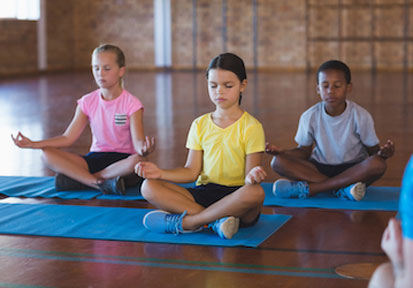Children can boost their mental wellness by learning and practicing mindfulness. It helps them be more aware of their thoughts and feelings “in the moment” and enables them to better manage their emotions and reactions. When children and teens accept their emotions, they can avoid becoming overwhelmed and suppressing their feelings. Practicing mindfulness can help reduce anxiety, improve performance, and build resilience. Bringing mindfulness into your family can help create calm and peaceful times together.
Mindfulness and kids
Mindfulness is knowing what’s going on inside of you at any given moment. What are you thinking? How are you feeling? How does your body feel? Being mindful means simply pausing to “check in” with yourself and recognize these thoughts, feelings, and sensations, without judgment. Kids might be more receptive to practicing mindfulness than adults because they tend to be more open, creative, and willing to learn. Teaching children to be mindful also taps into their sense of awareness and helps them “get connected” to how their bodies feel.
Research on how kids benefit from mindfulness is relatively new, but many results point to promising outcomes. Practicing mindfulness might help lessen kids’ anxiety symptoms and inattention. Some schools weave mindfulness training into their classes, and their students report greater self-esteem and experience more positive emotions. On the flip side, teens who score low in being mindful tend to struggle more with emotional, peer, and behavioral problems.
Practice mindfulness with your kids
Try to encourage your kids to take “mindful moments” throughout the day and check in with how they’re feeling and thinking. For example, ask them to focus on what it feels, sounds, smells, and tastes like to brush their teeth as they’re doing it. Getting connected to what they’re doing “in the moment” is practicing mindfulness.
Coach your kids' emotions to help them gain awareness of their feelings too. Encourage them to pause and recognize the emotion, label it with a name, and notice how it feels inside. From there, discuss how to best manage their emotions. For example, if your child is sad and disappointed because he or she feels “left out” by friends, being mindful draws awareness to that emotion before it becomes overwhelming. From there, you can guide your child on how to best deal with that emotion and the situation. Should your child confront her or his friends? Is this something that should be ignored? Ask your child, “What makes a good friend?” Discuss how to be a good friend and choose good friends. Mindfulness can open up doors to productive conversations.
Lastly, teach your kids mindfulness by taking a few moments before dinnertime to be mindful as a family. Encourage everyone to silently sit at the table for 2 minutes and focus either on how their bodies feel or a single thought. Ask them to close their eyes (for comfort) or focus on one non-moving object such as a picture on the wall. This mindfulness activity can bring calmness before enjoying your family meal together.
Learn more
If you’re new to mindfulness, a good place to start is using it to cope with your own emotions. The Families OverComing Under Stress (FOCUS) family program offers some aspects of mindfulness in their training sessions, which can help bring mindfulness to your family as well.
And find out how mindfulness can help kids tackle stress, reduce anxiety, and improve their focus.
